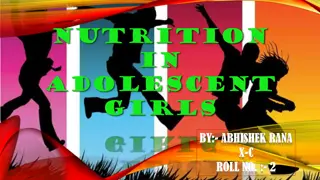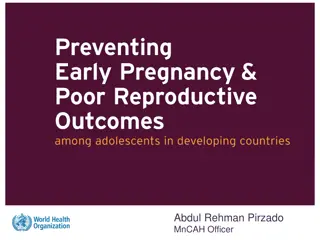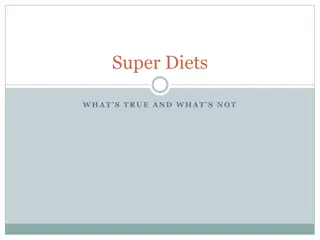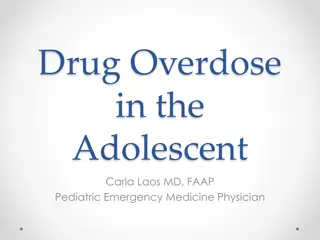Essential Diet Requirements for Adolescent Girls
Nutrition is crucial for adolescent girls as it impacts their future health and that of their offspring. Nutritional deficiencies during this period can lead to delayed physical growth, sexual maturation, and affect bone strength. Adequate nutrition prepares girls for potential pregnancy and lactation in the future, while under-nutrition can hinder learning, increase obstetric risks, and impact overall development. Adolescent girls require specific energy, protein, and fat intake to support growth, development, and overall well-being.
Download Presentation

Please find below an Image/Link to download the presentation.
The content on the website is provided AS IS for your information and personal use only. It may not be sold, licensed, or shared on other websites without obtaining consent from the author.If you encounter any issues during the download, it is possible that the publisher has removed the file from their server.
You are allowed to download the files provided on this website for personal or commercial use, subject to the condition that they are used lawfully. All files are the property of their respective owners.
The content on the website is provided AS IS for your information and personal use only. It may not be sold, licensed, or shared on other websites without obtaining consent from the author.
E N D
Presentation Transcript
Diet Diet Requirements Requirements For For Adolescent Girls Adolescent Girls
INDEX S.NO. TOPIC SLIDE NO. 1. Why nutrition is essential from adolescence girls 1-2 2. Detailed requirements for adolescence girls 5-6 3. Eating and snacking 7 4. Healthy eating Guidelines 8-9 5. Effects of caffeine as intake 10 6. Energy Requirements 11-14 7. Variations of Energy Required 15
Why nutrition is essential for adolescent girls ??? Any nutritional deficiency experienced during this critical period of life can have an effect on the future health of the individual and their offspring. For example, failure to consume an adequate diet at this time can result in delayed sexual maturation and delayed or retarded physical growth. The rapid physical changes of adolescence have a direct influence on a person's nutritional needs.
Adolescence is a time to prepare for the nutritional demands of pregnancy and lactation that girls may experience in later life. Under-nutrition negatively affects adolescent girls by: Affecting their ability to learn and work at maximum productivity; Increasing the risk of poor obstetric outcomes for teen mothers; Arresting the healthy development of future children; Affecting sexual maturation and growth: and Preventing the attainment of normal bone strength and the development of healthy teeth if a youth doesn't get enough calcium.
Energy Requirement Energy needs of adolescents are influenced by activity level, basal metabolic rate, and increased requirements to support pubertal growth and development. Adolescents need additional energy for growth and activity. Adolescent girls need approximately 2,200 calories each day.
Protein Protein needs of adolescents are determined by the amount of protein required for maintenance of existing lean body mass and the development of additional lean body mass during the adolescent growth spurt. In effect, protein is important for growth and maintenance of muscle. Adolescents need between 45 and 60 grams of protein each day. Most teens easily meet this requirement with their intake of beef, pork, chicken, eggs, and dairy products.
FATS AND OILS FATS AND OILS During adolescence, dietary fat continues to play important roles as an energy source, a significant cell structural component, a precursor to agents of metabolic function and a potent gene regulator. Effective strategies for reducing fat intake in children include the use of skim milk and choosing only lean meat.
CALCIUM It is estimated 45% of peak bone mass is attained during adolescence and so adequate calcium intake is important for the development of dense bone mass and the reduction of the lifetime risk of fractures and osteoporosis. In order to get the required 1,200 milligrams of calcium, teens are encouraged to consume three to four servings of calcium-rich foods each day. Milk provides the greatest amount of calcium in the diets of adolescents, followed by cheese, ice cream and frozen yogurt.
IRON The Recommended Allowance Dietary (RDA) for iron is 12-15 milligrams (mg) per day. Good sources of iron include beef, chicken, pork, legumes (including beans and peanuts), enriched or whole grains, and leafy green vegetables such as spinach. Iron is vital for transporting oxygen in the bloodstream. A deficiency of iron causes anaemia, which lead to fatigue, confusion, and weakness.
Eating and snacking patterns Adolescents tend to eat differently than they did as children. Preoccupied with after-school activities and engagement in active social endeavours, adolescents are not always able to sit down for three meals a day. These apparent busy schedules may lead to meal skipping, snacking throughout the day, and more eating away from home. . More importantly, eating too many fast foods can lead to weight gain and which may predispose one to diseases such as diabetes and heart disease.
Healthy Eating Guidelines for Girls aged 14-18 years 5-11 servings from the bread, cereals, rice, pasta, noodles group An example of one serve is 2 slices of bread; 1 medium bread roll; 1 cup of cooked rice, pasta or noodles; or 1 1/3 cup of breakfast cereal flakes. 4 servings from the vegetables, legumes group cup vegetables; or 1 small potato An example of one serve is 75 grams or 1/2 cup cooked vegetables; 1/2 cooked dried beans, peas, lentils or canned beans; 1 cup of salad
3 servings of fruit fruit (apricots, kiwi fruit, plums); 1 cup of diced fruit pieces or canned fruit; 1/2 cup of fruit juice; or 1 1/2 tablespoons of sultanas. 3 servings from the milk, yoghurt, cheese group An example of one serve is 1 medium apple; 2 small pieces (150g) of An example of one serve is 250 mls of fresh milk; 250ml of calcium fortified soy beverages; 40 grams (2 slices) of cheese; or 200g (1 small carton of yoghurt). 1 serving from the lean meat, fish, poultry, eggs, nuts and legumes group An example of one serve is 65-100 grams cooked meat or chicken; 2 small chops; 2 slices of roast meat; cup of cooked (dried beans); 80-120 grams of fish fillet; 1/2 cup of peanuts (almonds); or 2 small eggs.
Effects of caffeine as intake is increased Long-term effects of large amounts (greater than 600 mg/day) Moderate amounts (less than 600 mg/day) Large amounts (greater than 600 mg/day) Become more alert Find sleeping difficult Get headaches Heart rate increases Feel restless and jitteryWorry more Urinate more frequently Depression Feel nervous Body temperature rises Become deliriousHave stomach upsets More acid produced in digestive system Find it difficult to sleep May become addicted to caffeine
Energy requirements (kilojoules/day) About 9,500 kJ/day (2,270 cal/day)
Food Quantity Energy (kJ) Protein (g) Carbohydrate (g) Fat (g) Salt (Sodium, mg) Breakfast Cereal, flake, low sugar, fortified* 1 cup 475 2.04 25.17 0.21 324 Skim milk 1/2 cup 189 4.68 6.5 0.13 57 Orange juice, no added sugar 1 cup 362 1.58 18.64 0.26 13 Nutritious Snack Apple, unpeeled 1 medium 319 0.42 17.5 0.14 1 Carrot bran muffin 1 659 3.36 21.23 6.15 273 Water bottled 200ml 0 0 0 0 0
Lunch - Ham and salad roll Bread roll, mixed grain Long roll 760 6.08 31.25 2.6 353 Leg ham, fat trimmed 2 slices 219 7.69 0 2.39 649 Cucumber 3 slices 12 0.13 0.49 0.03 5 Avocado 2 slices 267 0.57 0.12 6.78 1 Lettuce 1 large leaf 6 0.14 0.06 0.02 3 Tomato 3 slices 30 0.45 0.86 0.05 3 Carrot, grated 1/3 cup 52 0.32 2.12 0.04 18 Low-fat chocolate milk 300ml carton 671 15.58 21.62 1.59 197 Fruit, nut & seed bar 1 small 399 1.38 10.64 4.4 22 27g bar
Nutritious Snack Bread, wholemeal 2 slices 757 7.52 29.83 2.31 382 Peanut butter, no added salt or sugar 6 teaspoons 974 10.39 3.04 19.35 0 Low-fat vanilla yoghurt 1 x 200g tub 652 11.8 24.2 0.4 158 Strawberries cup 79.2 1.36 2.16 0.08 4.8 Water 1 cup 0 0 0 0 0
Dinner - Beef and vegetable noodles Egg noodles 1/6 cup 561 5.3 25.6 0.6 68 Beef, fat trimmed 80g 663 22.24 0 7.68 46 Vegetable oil 1 teaspoon 170 0 0 4.6 0 Onion 1 small 35 0.41 1.43 0.02 3 Garlic 1/2 clove 6 0.07 0.11 0.03 0 Broccoli 1/2 cup flowerets 54 1.63 0.62 0.13 8 Snow pea 8 60 0.9 1.38 0.45 0 Oyster sauce 1 tablespoon 117 0.7 5.25 0.25 948 Chilli sauce 1 tablespoon 94 0.18 3.78 0.52 268 Low-salt soy sauce 1 teaspoon 9 0.28 0.14 0 184 Carrot 1 medium 66 0.42 2.73 0.05 20 Water 1 cup 0 0 0 0 0 Snack Vanilla ice-cream 2 scoops 388 1.75 10 5.35 30 Chopped peanuts 1 tablespoon 239 2.48 0.9 4.73 0.1
Variation to Energy Expenditure depending on Physical Activity Level for a girl 16 years, about 1.6m in height, weighing about 54kg Lifestyle/Exercise level Energy requirement (kJ/day) At rest, exclusively sedentary or lying (chair- bound or bed-bound) 7,200kJ/day Exclusively sedentary activity/seated work with little or no strenuous leisure activity eg office employee Lifestyle/Exercise level 8,400-8,950 kJ/day Energy requirement (kJ/day) Sedentary activity/seated work with some requirement for occasional walking and standing but little or no strenuous leisure activity eg drivers, students 9,500-10,100 kJ/day Predominantly standing or walking work eg shop workers 10,700-11,300 kJ/day Heavy occupational work or highly active leisure eg construction workers, farmers, high performance athletes. 11,900-13,100+ kJ/day
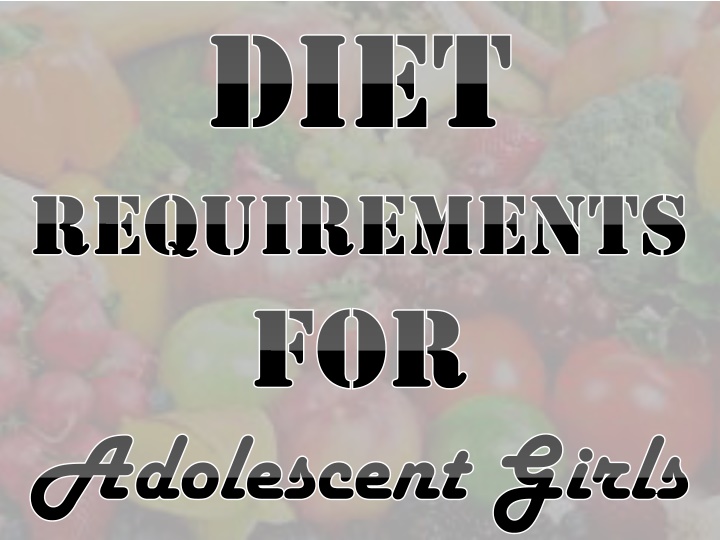

![READ [PDF] Dash diet Cookbook for beginners: 365 days of simple, healthy, low-s](/thumb/2057/read-pdf-dash-diet-cookbook-for-beginners-365-days-of-simple-healthy-low-s.jpg)








